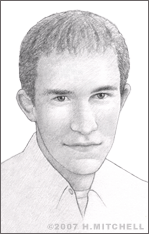Nathan Ball
Atlas Powered Ascenders
Think Spider Man’s ability to scale walls quickly looks like a skill that could come in handy in real life? That notion is now a reality with the invention of the Powered Rope Ascender, developed by Nathan Ball and classmates when he was a mechanical engineering student at the Massachusetts Institute of Technology (MIT).
Ball, born on May 13, 1983, grew up in Newport, Ore., where he was valedictorian of his high school class. He entered MIT in 2001 as a mechanical engineering student. He earned a bachelor’s degree in 2005, followed by a master’s degree in 2007.
In 2004, Ball entered MIT’s Soldier Design Competition, sponsored by the MIT Institute for Soldier Technologies. The challenge: to develop a high-powered device for enabling rapid vertical mobility. The competition called for students to create a system that was lightweight – less than 25 pounds – and could lift up to a 250-pound object 50 feet into the air in five seconds. This was a formidable task, but Ball and his teammates were playing to win. The device they built was able to meet the original specifications almost exactly – though it took seven seconds instead of five.
Ball’s device employed a novel rope-handling mechanism that functions similarly to a capstan used to lower an anchor on a ship; each time a rope is wrapped around a cylinder a tighter grip is achieved. Thus the grip tightens as more weight is tied to the line. In Ball’s version, a rope weaves among several specially configured rollers atop a turning spindle powered by a battery. The spindle continuously pulls the rope through the device.

Using drill batters and high-power density motors, Ball and his team were able to impress the competition organizers. At the conclusion of the contest, he and his team founded ATLAS Devices, to develop and market what they dubbed the ATLAS Powered Rope Ascender. He has since improved the design; it is now able to lift a 600-pound load at nearly 10 feet per second, up to 600 feet, on just one lithium-ion battery charge. The system weighs just 20 pounds and is the size of a handheld power tool.
Ball's system can be used in rescue work by firefighters and by military personnel; it also can be used in cave exploration and recreational climbing. The U.S. Army awarded funding for the device and ordered a substantial number for training and combat.
Ball created another impressive invention as a graduate student in MIT’s Bioinstrumentation Laboratory. As part of his master’s degree research, Ball worked on a project to advance drug delivery technology aimed at firing a drug directly through the skin at high velocity and pressure, eliminating the need for a needle. Using the Lorentz-force actuator that the lab developed earlier, he was able to solve a problem with the technology whereby only small amounts of drugs could be delivered. Within just a couple of months of beginning work on the issue, he created a binary valve technology that allowed higher volumes to pass and also improved the system overall. He and his colleagues hope that their work in this area will help make controllable needle-free injection (NFI) devices more affordable and accessible in the future.
In addition to his academic and entrepreneurial pursuits, Ball also shares much of his time working to encourage young people to become interested in science and technology. He worked on ideas for PBS Kid’s “Design Squad” program, for which he also served as host. In 2014, he wrote a series of children’s books to get children excited about engineering.
He has been honored with numerous awards, including the SAIC Award in the 2005 Soldier Design Competition and MIT’s 2005 Luis DeFlorez Award (for an electric scooter). In 2007, he was named winner of the $30,000 Lemelson-MIT Student Prize.


